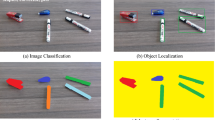Abstract
Most image segmentation algorithms extract regions satisfying visual uniformity criteria. Unfortunately, because of the semantic gap between low-level features and high-level semantics, such regions usually do not correspond to meaningful parts. This has motivated researchers to develop methods that, by introducing high-level knowledge into the segmentation process, can break through the performance ceiling imposed by the semantic gap. The main disadvantage of those methods is their lack of flexibility due to the assumption that such knowledge is provided in advance. In content-based image retrieval (CBIR), relevance feedback (RF) learning has been successfully applied as a technique aimed at reducing the semantic gap. Inspired by this, we present a RF-based CBIR framework that uses multiple instance learning to perform a semantically-guided context adaptation of segmentation parameters. A partial instantiation of this framework that uses mean shift-based segmentation is presented. Experiments show the effectiveness and flexibility of the proposed framework on real images.















Similar content being viewed by others
References
Bhanu B, Lee S, Das S (1995) Adaptive image segmentation using genetic and hybrid search methods. IEEE Trans Aerosp Electron Syst 31(4):1268–1291
Bhanu B, Lee S, Ming J (1995) Adaptive image segmentation using a genetic algorithm. IEEE Trans Syst Man Cybern 25(12):1543–1567
Borenstein E, Ullman S (2004) Learning to segment. In: European conference on computer vision, pp 315–328
Carson C, Belongie S, Greenspan H, Malik J (2002) Blobworld: color and texture-based image segmentation using EM and its applications to image querying and classification. IEEE Trans Pattern Anal Mach Intell 24(8):1026–1038
Chen Y, Wang J (2002) A region-based fuzzy feature matching approach to content-based image retrieval. IEEE Trans Pattern Anal Mach Intell 24(9):1252–1267
Comaniciu D (2003) An algorithm for data-driven bandwith selection. IEEE Trans Pattern Anal Mach Intell 25(2):281–288
Comaniciu D, Meer P (2002) Mean shift: a robust approach toward feature space analysis. IEEE Trans Pattern Anal Mach Intell 24(5):603–619
Datta R, Joshi D, Li J, Wang JZ (2008) Image retrieval: ideas, influences, and trends of the new age. ACM Comput Surv 40(2):1–60
Dietterich TG, Lathrop RH, Lozano-Pérez T (1997) Solving the multiple instance problem with axis-parallel rectangles. Artif Intell 89(1–2):31–71
Duda RO, Hart PE, Stork DG (2000) Pattern classification, chapter 4, 2nd edn. Wiley, New York
Fan J, Yau DKY, Elmagarmid AK, Aref WG (2001) Automatic image segmentation by integrating color-edge extraction and seeded region growing. IEEE Trans Image Process 10(10):1454–1466
Gondra I, Xu T (2008) Adaptive mean shift-based image segmentation using multiple instance learning. In: Proceedings of IEEE international conference on digital information management, pp 716–721
Gu IYH, Gui V (2001) Colour image segmentation using adaptive mean shift filters. In: Proceedings of IEEE international conference on image processing, vol 1, pp 726–729
Guy G, Medioni G (1996) Inferring global perceptual contours from local features. Int J Comput Vis 20(1–2):113–133
Li J, Wang J, Wiederhold G (2000) IRM: integrated region matching for image retrieval. In: Proceedings of ACM conference on multimedia, pp 147–156
Maron O, Lozano-Pérez T (1998) A framework for multiple-instance learning. In: Jordan MI, Kearns MJ, Solla SA (eds) Advances in neural information processing systems, vol 10. MIT, Cambridge
McQueen J (1967) Some methods for classification and analysis of multivariate observations. In: Proceedings of the 5th Berkeley symposium on mathematical statistics and probability, vol 1, pp 281–297
Pal NR, Pal SK (1993) A review of image segmentation techniques. Pattern Recogn 26(9):1277–1294
Pearl, J (1988) Probabilistic reasoning in intelligent systems: networks of plausible inference. Morgan Kaufmann, San Francisco
Peng J, Bhanu B (1998) Closed-loop object recognition using reinforcement learning. IEEE Trans Pattern Anal Mach Intell 20(2):139–154
Schnitman Y, Caspi Y, Cohen-Or D, Lischinski D (2006) Inducing semantic segmentations from an example. In: Asian conference on computer vision, pp 384–393
Shi J, Malik J (2000) Normalized cuts and image segmentation. IEEE Trans Pattern Anal Mach Intell 22(8):888–905
Smeulders AW, Worring M, Santini S, Gupta A, Jain R (2000) Content-based image retrieval at the end of the early years. IEEE Trans Pattern Anal Mach Intell 22(12):1349–1380
Tu Z, Zhu S.C (2002) Image segmentation by data-driven Markov chain and Monte Carlo. IEEE Trans Pattern Anal Mach Intell 24(5):657–673
Wang Y, Yang J, Peng N (2006) Unsupervised color-texture segmentation based on soft criterion with adaptive mean-shift clustering. Pattern Recogn Lett 27:386–392
Xu T, Gondra I (2009) Texture map: an effective representation for image segmentation. In: Proceedings of the C3S2E conference. ACM, New York, pp 197–203
Zhou XS, Huang TS (2003) Relevance feedback in image retrieval: A comprehensive review. Multimedia Syst 8(6):536–544
Author information
Authors and Affiliations
Corresponding author
Rights and permissions
About this article
Cite this article
Gondra, I., Xu, T. A multiple instance learning based framework for semantic image segmentation. Multimed Tools Appl 48, 339–365 (2010). https://doi.org/10.1007/s11042-009-0347-z
Published:
Issue Date:
DOI: https://doi.org/10.1007/s11042-009-0347-z




